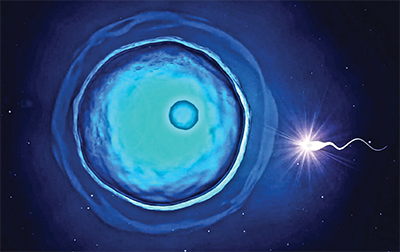MCP: Sperm-quality study updates advice for couples
Could doctors at fertility clinics be giving men bad advice? Two clinician–researchers at the Center for Reproductive Medicine of Shengjing Hospital in Shenyang, China, think so.
from Da Li and XiuXia Wang’s labs, published in the journal Õµ≈ƒÕµø˙ & Cellular Proteomics, upends conventional wisdom that abstaining between efforts to conceive can improve a couple’s chances of success. The research team worked with almost 500 couples to test whether how long a couple waits between efforts to conceive could change their success rate.
 An artist’s representation of fertilization of an oocyte by a sperm cell.Courtesy of Karl-Ludwig Poggemann/Flickr
An artist’s representation of fertilization of an oocyte by a sperm cell.Courtesy of Karl-Ludwig Poggemann/Flickr
“For years, men have usually been advised to limit sexual activity to increase the chances of pregnancy,” said Li. “However, it’s time to change our minds.”
Some earlier studies had shown that semen produced shortly after a man’s most recent ejaculation — within three hours or so — had faster and more motile sperm than if the man abstained for several days before ejaculating again. But it wasn’t clear why the sperm changed or whether the changes affected fertility. So researchers set up a few side-by-side experiments.
They looked at individual subjects’ semen after they had abstained for either several days or just an hour or two, comparing the volume of semen and the mobility of sperm. As had been observed earlier, the sperm from shorter abstinence periods moved faster.
Using mass spectrometry to look at the protein makeup of the samples, the team found major molecular differences. The majority of the affected proteins were involved in cell adhesion, a function that sperm need in order to fuse with egg cells.
The team also observed changes to proteins involved in sperm motility and metabolism, especially proteins that handle reactive oxygen species, a byproduct of cellular energy production. Although reactive oxygen species are needed for some normal sperm functions, an excess can damage sperm’s genetic material.
According to Li and Wang’s results, the longer sperm exist, the more vulnerable they are to DNA damage by reactive oxygen, which could harm their ability to form a viable embryo.
To see whether the changes to sperm were affecting fertility, the research team also ran a study of about 500 couples preparing for in vitro fertilization at the fertility clinic. They asked men in the control group for semen samples after several days of abstinence, whereas men in the experimental group abstained for less than three hours before providing their samples. The IVF team proceeded as usual with the two types of sample, using them to generate and then implant embryos.
“A typical live birth rate in a cohort of this size is about 30 percent,” Li said. In the experimental cohort, live births were higher by one-third.
“Our data indicate that couples with relatively normal semen parameters should have frequent sex around the ovulation period,” Li said. “This could make all the difference to their efforts to start a family.”
Meanwhile, IVF treatments at the Center for Reproductive Medicine, which treats about 5,000 infertile couples per year, also are being updated to use semen from more closely spaced ejaculations.
The team plans to continue working with patients, Li said, and will investigate differences in post-translational modifications that his lab saw between the types of samples. “This is a very new field,” he said, noting that there are many unanswered questions about the changes the team observed.
Enjoy reading ASBMB Today?
Become a member to receive the print edition four times a year and the digital edition weekly.
Learn moreGet the latest from ASBMB Today
Enter your email address, and we’ll send you a weekly email with recent articles, interviews and more.
Latest in Science
Science highlights or most popular articles

Transforming learning through innovation and collaboration
Neena Grover will receive the William C. Rose Award for Exemplary Contributions to Education at the 2025 ASBMB Annual Meeting, April 12–15 in Chicago.

Guiding grocery carts to shape healthy habits
Robert “Nate” Helsley will receive the Walter A. Shaw Young Investigator in Lipid Research Award at the 2025 ASBMB Annual Meeting, April 12–15 in Chicago.

Quantifying how proteins in microbe and host interact
‚ÄúTo develop better vaccines, we need new methods and a better understanding of the antibody responses that develop in immune individuals,‚Äù author Johan Malmström said.

Leading the charge for gender equity
Nicole Woitowich will receive the ASBMB Emerging Leadership Award at the 2025 ASBMB Annual meeting, April 12–15 in Chicago.

CRISPR gene editing: Moving closer to home
With the first medical therapy approved, there’s a lot going on in the genome editing field, including the discovery of CRISPR-like DNA-snippers called Fanzors in an odd menagerie of eukaryotic critters.

Finding a missing piece for neurodegenerative disease research
Ursula Jakob and a team at the University of Michigan have found that the molecule polyphosphate could be what scientists call the “mystery density” inside fibrils associated with Alzheimer’s, Parkinson’s and related conditions.

